Understanding Kiteboard Closeouts: Performance Impact
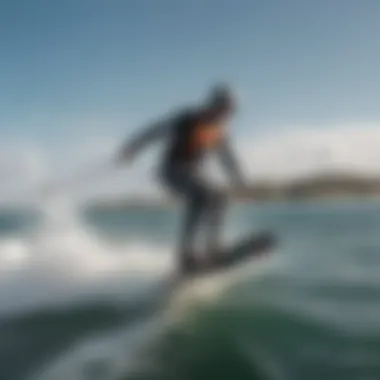
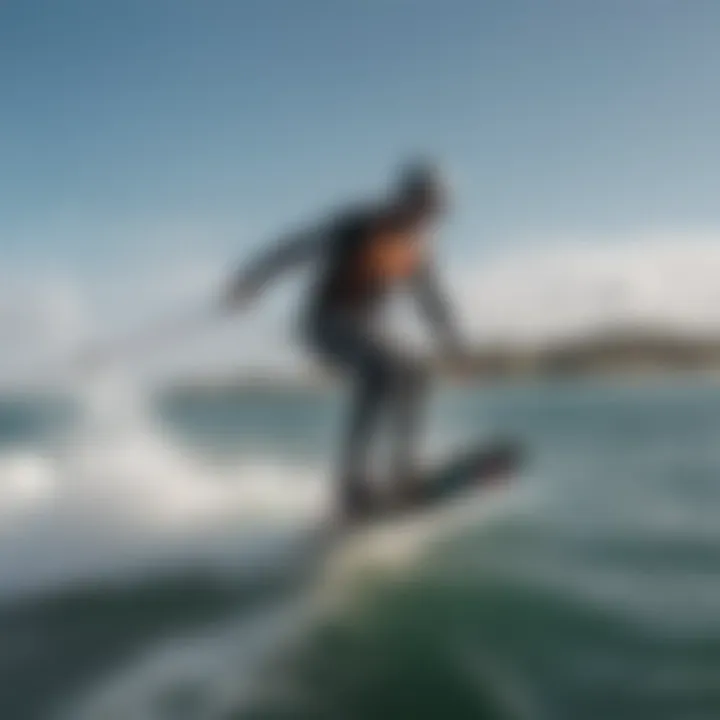
Intro
In the world of kiteboarding, conditions can change on a dime. Among those changes, closeouts stand out as a critical phenomenon that directly impacts both performance and safety. Understanding the dynamics behind kiteboard closeouts is not merely for advanced riders; it is essential for all levels, from fledgling enthusiasts to seasoned pros.
As we navigate through this in-depth analysis, we will delve into what constitutes a kiteboard closeout, the various factors contributing to such conditions, and the ramifications they carry for every kiteboarder. This exploration will also shed light on the implications for decision-making while kiteboarding, revealing strategies for both recognizing and adapting to closeout situations.
By enhancing your understanding of this topic, you not only enrich your own kiteboarding experience but also equip yourself with knowledge vital for safety and performance on the water.
Equipment Insights
Latest Gear Reviews
When it comes to kiteboarding, the gear you use plays a pivotal role in your performance during closeout conditions. The market has recently seen innovative advances. For instance, brands like North Kiteboarding and Cabrinha have introduced kites designed specifically with enhanced stability and control. Their latest models incorporate features like adjustable bridles and improved depower settings that respond well when navigating choppy waters and closeout scenarios.
In terms of boards, the Shinn Kiteboarding range offers lightweight, durable options that provide excellent traction during challenging conditions. Riders appreciate how these boards handle turbulence—key when trying to maintain control amidst the shifting tides.
Essential Gear Maintenance
Proper maintenance of your gear is paramount, especially when contending with the stresses of closeout conditions. Regularly inspect your kite for any signs of wear, as small tears can lead to significant challenges under pressure. Cleaning your gear after each session helps prevent saltwater corrosion, prolonging the lifespan of both kites and boards.
"A stitch in time saves nine." It's easier to make small repairs than to deal with a damaged kite on your next ride.
Some useful maintenance tips include:
- Regularly check your lines for frays or knots that could compromise performance.
- Rinse your gear with fresh water after every session to remove salt and sand.
- Store your kite in a cool, dry place to avoid any mold or deterioration from dampness.
Being proactive about your equipment care can mean the difference between a thrilling ride and a rough day on the water.
Technique Exploration
Beginner Techniques
For those just starting, awareness of closeouts will come with experience, but fundamental techniques can help ease the process. Learning to read the waves and recognizing the tell-tale signs of a closeout—such as a rapid steepening of the swell—is crucial. Beginners should focus on gaining basic skills in controlling the kite, learning to edge the board properly, and timing their jumps effectively.
Advanced Maneuvers
As riders progress to advanced techniques, the dynamic nature of closeouts will require more refined skills. Advanced maneuvers include:
- Power jumps that allow for quick elevation above the incoming wave, reducing impact.
- Downwind riding, providing a smoother path less impacted by breaking swells.
- Transitions that keep momentum while navigating closeouts help maintain flow and rhythm while riding.
Each of these maneuvers not only requires skill but also an acute understanding of the water's behavior under duress. The ability to predict wave actions can translate directly into enhanced safety and performance.
In this analysis of kiteboarding closeouts, we will carefully examine these insights and techniques throughout the following sections. Join us as we explore strategies and experiences that will fully equip you for your adventures on the water.
Understanding Kiteboard Closeouts
Kiteboarding, an exhilarating blend of surfing and flying, enthralls practitioners with its dynamic nature and the freedom it offers. However, not all moments spent on the water are created equal. Understanding kiteboard closeouts is vital, as they significantly influence a rider's performance, safety, and overall experience in the sport. This section aims to lay the groundwork, shining a light on the importance of recognizing and navigating these conditions effectively.
First off, the essence of kiteboard closeouts stems from the waves crashing simultaneously across various areas, rendering sections of the ocean or any other body of water less favorable for riding. When you encounter a closeout, it usually means that the waves are too chaotic to ride or jump over safely. Thus, for any kiter, grasping the concept of closeouts is not just about understanding wave behavior; it's about ensuring safety and mastering technique.
One major benefit of digging into closeouts is its impact on personal skill development. By comprehending what a closeout truly looks like, riders can adapt their style and mentality. This knowledge can reduce anxiety and build confidence. For instance, a skilled kiter could navigate a turbulent area using techniques learned from analyzing closeout situations, while the novice might panic and head straight for trouble.
Additionally, closeouts have unique implications for teaching and coaching. Instructors who can explain the nuances of waves and wind patterns will arm their students with practical knowledge. This will be vital for developing responsible kiteboarders who know when to push their limits and when to back off.
In summary, the significance of understanding kiteboard closeouts cuts across various layers of the sport, from enhancing individual skills to fostering safe riding environments. This set of knowledge not only enriches the experience of learning and teaching kiteboarding but also establishes safer practices in what can be a thrilling yet risky activity.
Identifying Closeout Conditions
Identifying closeout conditions is a crucial skill that can greatly influence the experience of a kiteboarder. These conditions refer to specific environmental and personal factors that lead to waves breaking suddenly and unpredictably, making it difficult to control the board and kite. Understanding how to identify these conditions maximizes safety and enhances performance, especially for those who are just starting out or those pushing their limits. It is essential to develop an acute awareness of various indicators that signal approaching closeouts, ensuring each rider can navigate these potentially hazardous situations effectively.
Environmental Indicators
Wave Height
Wave height can be a telltale sign of what kiteboarders might encounter out on the water. Generally, taller waves are easier to read, but they come with their own set of challenges. High waves can signal stronger currents and rapidly changing conditions. For kiteboarders, understanding wave height is paramount as it relates directly to the power and control available.
One key characteristic of wave height is its direct link to wind conditions and storm activity. A range of two to four feet is often seen as manageable, allowing for more proficient technique application while providing enough excitement. However, once you exceed that range, it can become a real mixed bag.
- Advantages of Monitoring Wave Height:
- Disadvantages:
- Builds skills in timing and catching waves.
- Enhances the ability to predict erratic breaks.
- High waves can easily toss even seasoned riders if they aren't cautious.
- Misjudging height can lead to poor maneuvers and accidents.
Wind Speed and Direction
Wind speed and direction can significantly impact kiteboarders' abilities to perform well. The right combination of these factors can either elevate or devastate a kiteboard session. Generally, moderate winds, around 15 to 25 knots, create prime conditions for a thrilling ride. However, strong gusts can lead to turbulent waters and, consequently, abrupt closeouts.
- Key Characteristics:
This type of physical force can transform the water surface from a glassy, ideal setup to chaotic conditions in seconds. Understanding wind patterns also keeps riders alert to possible changes in just about any session. - Unique Features:
The direction helps in identifying the best areas to ride. - Advantages:
- Disadvantages:
- Being aware of these elements enables optimal launching and landing techniques.
- It assists in anticipating changes, promoting a higher level of safety.
- Unpredictable gusts can result in severe wipeouts.
- Strong winds might compel riders to choose less suitable spots to ride, adding to risk.
Tidal Influence
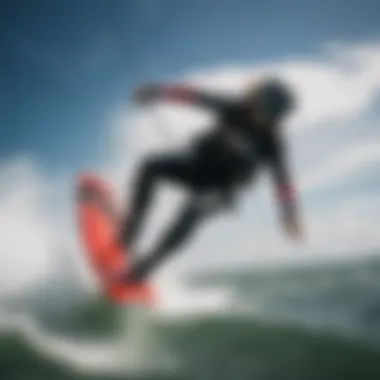
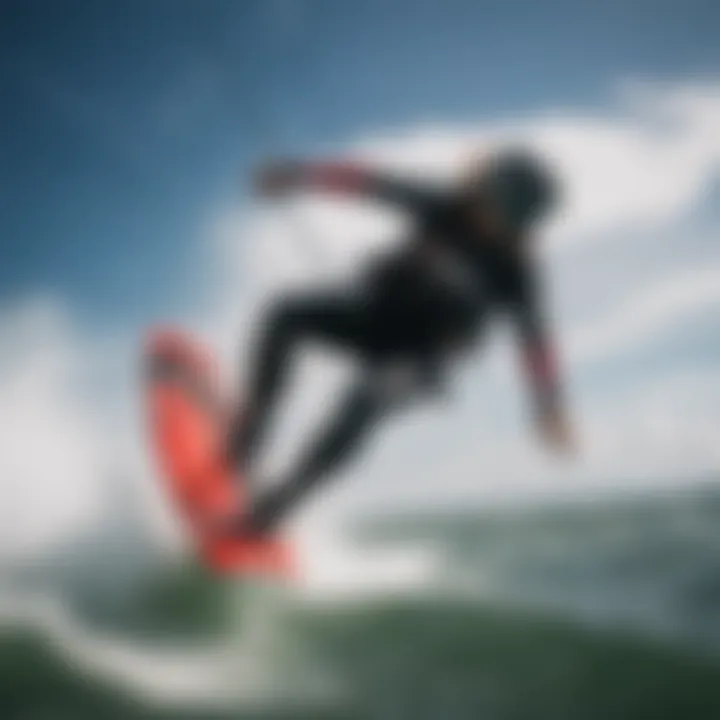
Tides are another factor that greatly affects water conditions for kiteboarders. The tide’s cycle, whether incoming or outgoing, can change the behavior of waves and water flow. As the tide rises, it can create more powerful waves, while a falling tide can lead to complete flatness or a rapid transition to closeouts.
Understanding tidal influence is a key component for riders planning their sessions, particularly in coastal regions where tide swings can be severe.
- Key Characteristics:
The tidal range affects wave height and breaks significantly, which requires close observation through the day. - Advantages:
- Disadvantages:
- Allows for strategic timing in sessions, optimizing the likelihood of good conditions.
- Provides insight for planning safer exits and entries.
- Misjudging the timing can lead to by surprise waves and landscape shifts, posing risks to the rider.
- Strong tidal flows can make managing speed and control challenging, especially for less experienced riders.
Personal Skill Level Considerations
Beginner vs. Advanced Perspectives
When discussing closeout conditions, perspectives vary significantly between beginners and advanced riders. For novices, these conditions can often feel overwhelmingly daunting. They may need to approach closeouts with heightened caution and care. For them, every break and jab of the board can be unnerving.
An advanced rider, on the other hand, may perceive closeouts differently. With experience comes a deeper understanding of the risks involved, and many riders are able to incorporate these challenges into their riding style. They recognize the potential for thrills instead of simply a frightening encounter.
- Key Characteristics:
An advanced rider might adjust their speed and trajectory accordingly to avoid the worst of closeouts seamlessly. - Advantages for Beginners:
- Disadvantages for Beginners:
- Learning to identify closeouts effectively builds a solid foundation for safe riding.
- It fosters skills that will be invaluable in harsher conditions later in their journey.
- A lack of experience can lead to misjudgment of limits, resulting in potential accidents.
Risk Assessment
Risk assessment involves gauging the conditions of both the environment and one's skills before attempting to kiteboard. It includes evaluating wave conditions, personal safety gear, and understanding one’s own abilities. It’s about taking a good hard look at what could go right, or very wrong.
Being able to effectively assess risks can significantly lower the likelihood of accidents. This skill is especially crucial when kiteboarders venture into areas that can seem deceptively calm.
- Key Characteristics:
Risk assessment often hinges on how familiar a rider is with both the local environment and their equipment. - Advantages:
- Disadvantages:
- Increases confidence when hitting the water, knowing one's skill level is well matched to conditions.
- Promotes safety-first approaches that can prevent injuries and enhance overall enjoyment.
- Over or underestimating risks can have dire consequences.
- Excessive caution might lead to missed opportunities for improvement and learning.
Implications of Closeouts on Performance
Kiteboarding isn't just about riding the wind and waves; it's about understanding the nuances of your environment, especially when it comes to closeouts. When kiteboarders encounter closeout conditions, the implications on performance span both the physical act of riding and the mental clarity needed to tackle the challenges. Closeouts can drastically affect a rider's maneuverability and control. Recognizing how these conditions manifest means riders can adjust techniques accordingly, enhancing performance and safety. Riders who grasp the nuances of closeouts are better equipped to navigate tricky scenarios, ensuring that they maintain a steady course in unpredictable waters.
Impact on Riding Techniques
Gust Management
Gust management stands as a crucial aspect of kiteboarding when facing closeout conditions. It involves understanding and harnessing the wind's unpredictability. When windy conditions fluctuate, a rider's response needs to be swift and informed. A key characteristic of gust management is the ability to maintain control despite rapid shifts in wind strength. This skill is indispensable for kiteboarders aiming for stability and fluidity in their rides.
Gust management is popular among seasoned kiteboarders, primarily due to its direct correlation with performance enhancement. By learning to read and adapt to varying wind conditions, riders can finesse their timing and execution of maneuvers, ultimately leading to a smoother ride. However, gust management also has its downsides. If a rider misjudges a gust's strength or direction, the result can be a collision with the water’s surface or, worse, other riders. A careful balance is needed for this technique.
Jumps and Tricks
In the context of closeouts, jumps and tricks become less about showboating and more about survival and technique. The nature of closeouts can either present a challenge or an opportunity for the kiteboarder willing to adapt. A fundamental aspect of executing jumps is timing, which can be significantly altered by the conditions generated by closeouts. Experienced riders know that jumps need precision in recognizing the right moment to launch from a wave's crest, especially when that wave is forming rapidly.
Jumps and tricks hold a unique feature in the world of kiteboarding, where performance can hinge on the rider's ability to maintain aerial control amidst the chaotic backdrop of closeouts. This makes aerial maneuvers a valuable skill, boosting the rider's confidence, and showing off their prowess. Nevertheless, the risk is ever-present; these maneuvers can lead to hard landings or even wipeouts if not executed properly.
Safety Considerations
In kiteboarding, safety is paramount, especially considering the potential pitfalls inherent to closeouts.
Collision Risks
Collision risks are paramount while kiteboarding in closeout conditions. With the chaotic interaction between powerful waves and unpredictable wind, the likelihood of colliding with other riders or obstacles increases. A key characteristic of understanding collision risks is the awareness of one's surroundings at all times. This awareness enables riders to anticipate hazards and adjust accordingly.
This focus on safety isn't just beneficial—it's essential. Riders must develop situational awareness, which influences their decisions on when to jump or when to retreat. However, while having heightened awareness is advantageous, an excessive focus on potential collisions may lead to paralysis by analysis. Balancing awareness with calmness under pressure is crucial.
Self-Rescue Techniques
Self-rescue techniques are invaluable skills for kiteboarders, particularly in challenging closeout situations. They encompass the series of maneuvers a rider performs to regain control of their kite and themselves after losing stability. A defining characteristic of self-rescue techniques is the fundamental understanding of how to disconnect and control the kite while safely navigating back to shore.
These techniques are vital for promoting rider safety, as they equip individuals with the skills needed to handle emergencies efficiently. A rider well-versed in self-rescue can handle unforeseen situations better, minimizing the risks associated with closeouts. The downside? These techniques require practice to be effective, and without proper training, a rider might find themselves overwhelmed in dire conditions.
Understanding the implications of closeouts on performance helps kiteboarders make informed decisions amid the chaos of wind and water. With the right knowledge and skills, they can turn challenges into opportunities for growth.
Strategies for Navigating Closeouts
Navigating kiteboard closeouts is not just about surviving the chaos – it's an art in itself. These strategies equip kiteboarders with the right mindset and tools to handle challenging conditions while minimizing risks. Effectively employing these strategies can enhance a rider's confidence and skill set, making an unpredictable experience manageable and even enjoyable. Adjusting to closeouts requires a blend of technical proficiency and heightened awareness, which can improve overall performance and reduce anxiety during those nerve-racking moments on the water.
Technique Adaptation
Small Board Tricks
Small board tricks make an essential part of navigating closeout conditions. These moves allow kiteboarders to remain agile when encountering turbulent water. The notable characteristic of small board tricks is their ability to facilitate quicker maneuvers; hence, they can come in handy during a closeout episode. The lighter design and reduced surface area of smaller boards often contribute to their popularity, as they enable riders to perform quicker rotations and transitions. Moreover, small boards can improve buoyancy, which gives an edge when the water becomes choppy. Nevertheless, opting for a small board can have its downsides, such as reduced overall stability, which can be a challenge when waves and wind conditions fluctuate.
Edge Control
Edge control plays a crucial role in kiteboarding, especially when attempts are being made to navigate closeouts successfully. This technique involves managing the point at which the board meets the water, allowing full use of the edge for more precise turns and speed regulation. Mastering edge control enhances the rider's ability to pump the board during critical moments when the water reacts unexpectedly. The essential characteristic of edge control is the fine-tuned balance it provides; it is particularly useful for those encountering adverse water conditions. Riders with strong edge control can effectively navigate through chop and manage powerful gusts. However, achieving optimal edge control requires time and practice, lending itself to a learning curve for both novice and advanced participants.
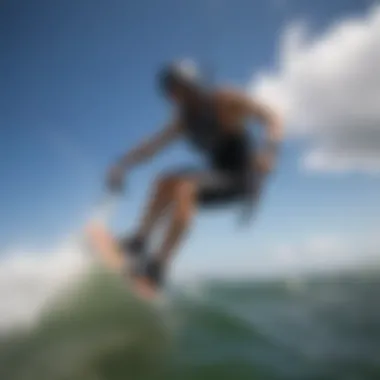
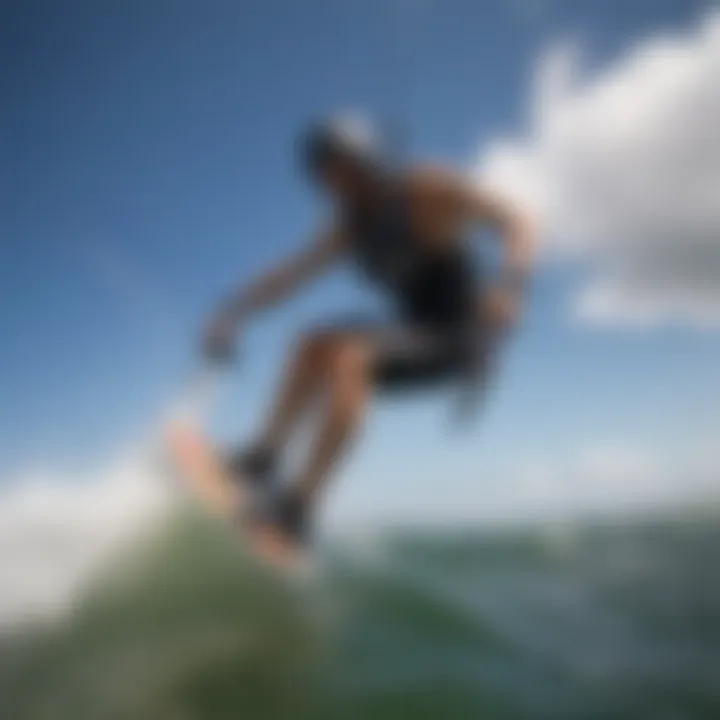
Situational Awareness
Reading the Water
Reading the water is paramount for anticipating changes and assessing risk while kitesurfing in closeout situations. This skill entails coming to grips with surface conditions, wave patterns, and the interplay between wind and water. Excelling at reading the water underscores a rider's ability to make informed decisions, adjusting their technique to mitigate potential hazards. Furthermore, this knowledge can lead to discovering favorable sections on the water surface. Notably, knowing how to read the water can be a game-changer, especially in fast-moving situations where every second counts. However, honing this skill requires keen observation and experience, which can present difficulty for aspiring kiters just starting out.
Predictive Analysis
The practice of predictive analysis involves anticipating changes in wind and water conditions before they manifest. Recognizing trends and consequences based on accumulated data can provide a significant advantage, transforming the riding experience entirely. A pivotal characteristic of predictive analysis is the ability to assess risk and develop strategies in advance, allowing riders to make split-second decisions that can avoid closeout complications. Its upsides are clear; a proactive approach fosters safety and boosts confidence. However, the downside lies in the inherent unpredictability of weather and water conditions, which can make any predictions moot an a few moments.
"Knowledge and anticipation make the difference between enjoying your kiteboard experience or going for an unwanted swim."
Utilizing these strategies can have a lasting impact on your kiteboarding experience. As riders develop their technical skills and situational awareness, they become more adept at navigating the intricate dynamics of kiteboard closeouts. Such preparedness not only enhances individual performance but also promotes a safer environment for everyone on the water.
Training and Development for Closeout Scenarios
Training for closeout scenarios is the backbone of effective kiteboarding practice. These situations can crop up unexpectedly, causing anxiety for riders of all skill levels. Fostering a solid understanding of training techniques can equip kiteboarders to tackle these challenges head-on. Emphasizing adaptability, practicing muscle memory, and simulating closeout conditions are vital for elevating performance and safety.
Focus on Muscle Memory
Muscle memory plays a critical role in how kiteboarders react under pressure. When riders experience intense conditions, instinctive responses govern their actions. By repeatedly practicing maneuvers, riders engrain these movements into their bodies. This repetition trains the brain and muscles to work in harmony. Just as a basketball player shoots hoops over and over until the shot becomes automatic, kiteboarders need to refine their reactions in closeout scenarios.
To build these reactions, regular training must incorporate diverse conditions. Practicing in varied wind speeds and wave patterns encourages flexibility and adaptability. With focused practice, riders can naturally respond to the sudden changes that accompany closeouts. As they say, "practice makes perfect" rings especially true.
Simulation of Closeout Conditions
Simulating closeout conditions can be a game changer for preparing individuals to face them in reality. This facet benefits riders greatly, leading to heightened awareness and improved techniques. The unpredictability of closeouts can leave one feeling unsettled, but by creating drills and exercises honing in on these situations, kiteboarders can develop the skills needed to navigate them.
Drills and Exercises
Drills specifically designed for closeout scenarios emphasize quick reflexes and situational awareness. These exercises may include practicing rapid kite adjustments, quick turns, and efficient water starts in simulated closeout settings.
One key characteristic of these drills lies in their ability to mimic real-life conditions without the actual risk. Engaging in well-structured training sessions can help reduce fear and build confidence.
Some benefits of these drills are:
- Enhanced Reaction Time: Riders learn to make snap decisions.
- Controlled Environment: Training can occur away from the hazards of open water, allowing for focused practice without injury risks.
- Improved Tactical Thinking: Riders develop strategies to respond to various closeout conditions.
However, a potential downside is the possibility of over-reliance on drills, which might lead to rigidity in tactics when faced with unforeseen circumstances.
Video Analysis
Video analysis holds immense value in understanding closeout dynamics. Watching recordings allows riders to dissect their performance, identifying areas needing improvement without the pressures of real-time decision-making. This reflective practice encourages a deeper understanding of movement efficiency, body positioning, and overall technique.
The main allure of video analysis is its simplicity and effectiveness. Using footage, riders can break down each aspect of their riding and confront mistakes directly. This method facilitates targeted learning, focusing on specific weaknesses, thereby enhancing overall performance.
Some significant aspects include:
- Critical Feedback: Visual reviews often highlight mistakes missed during the ride.
- Progress Tracking: Seeing improvement over time keeps motivation high.
- Team Learning: Riders can analyze together, fostering discussion and collective growth.
However, it’s important to balance this analysis with real-life experience. Too much focus on video can sometimes detract from the raw instincts that form through actual riding.
"Kiteboarding is about finding that sweet spot between confidence and caution. Training helps you find it, even in the chaos of a closeout."
Overall, prioritizing training and development in these areas can significantly enhance a kiteboarder's performance while also improving safety, ensuring they are ready to ride the waves with both skill and assurance.
Gear Considerations in Closeout Conditions
When kiteboarding, the right gear can make all the difference, especially during closeout conditions. Understanding how your equipment interacts with these scenarios is crucial for maximizing performance and safety. Gear considerations encompass more than just picking pretty colors or reputable brands; they involve a deep dive into how each component behaves in specific water and wind environments.
Kite Selection
Types of Kites
In the realm of kiteboarding, kites come in various shapes and sizes, each tailored to different riding styles and conditions. The two primary types of kites are inflatable kites and foil kites. Inflatable kites are widely favored for their ease of use and stability, making them a popular choice among both beginners and advanced riders.
A key characteristic of inflatable kites is their ability to maintain form through air pressure, providing essential lift that can handle rough conditions. Their unique feature allows for faster recovery after crashes, which is particularly advantageous during closeout situations where timing is everything. However, one must be cautious, as the aggressive wind conditions could lead to trouble if not managed well.
Size Variations
Kite size plays a pivotal role in navigating closeout conditions. Generally, larger kites catch more wind and can generate more power, which might seem beneficial, but they can also make riders feel overpowered in strong winds. A smaller kite, meanwhile, may require more skilled handling but could prove less taxing in tumultuous conditions, allowing for better control.
Choosing the right size is crucial. Riders should consider their weight, the wind strength, and the type of closeouts they expect to encounter. When out in the field, having a kite that’s not too big nor too small can mean the difference between a controlled ride and an unintended swim to shore.
Board Features
Shape and Volume
The shape and volume of your board directly impact how it performs in closeout conditions. A board with a flatter shape tends to ride smoother on choppy waters, offering more stability. Conversely, a board with pronounced rocker can be beneficial for slashing through waves but might require more skill to manage effectively.
One significant feature here is the volume; boards with more volume float better and can help in softening the impact when hitting choppy waters. This can help prevent wipeouts during closeouts, yet riders should beware that increased volume can create drag, potentially slowing them down in higher-speed situations.
Fin Configurations
Fin configurations have a profound effect on how a board reacts to water conditions. For instance, shorter fins can help in gaining speed and maneuverability, while longer fins provide stability and control, especially in rough waters.
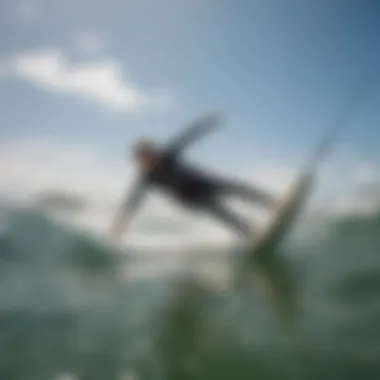
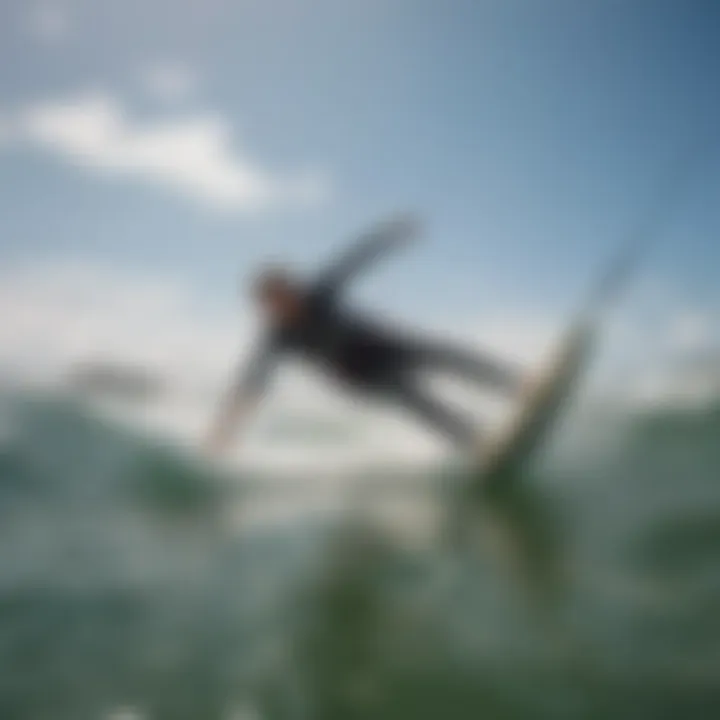
Choosing the right configuration revolves around matching the conditions. For closeouts, a setup that allows for quick turns and rapid responses can be life-saving. A rider might find it advantageous to experiment with different fin setups to understand what works best for them based on their skill level and the nature of the waves. Attuning to effective fin use can significantly enhance not only performance but also safety.
"Your gear isn’t just there to look good; it’s your life raft in unpredictable waters. Choose wisely."
In summary, the importance of understanding gear considerations in closeout conditions cannot be overstated. Kite and board features, from their types to their configurations, play a pivotal role in the kiteboarding experience. Careful attention to these elements not only boosts performance but also enhances the safety and enjoyment of the ride.
The Psychological Aspect of Closeouts
Understanding the psychological elements of kiteboard closeouts is crucial. It’s not just about weather patterns or wave sizes; it’s about how a rider's mind processes these conditions. Addressing the psychological factors—like fear and preparation—can play a significant role in enhancing performance and safety. This section explores two core areas that influence a rider’s responses to closeout conditions: fear management and mental preparation.
Fear Management
Overcoming Anxiety
When kiteboarders face closeouts, anxiety often rears its head. This anxiety can stem from an overestimation of dangers or a lack of confidence in skills. Overcoming this anxiety is essential. One key characteristic of overcoming anxiety is that it allows for clearer decision-making in critical moments. When riders can control their fears, they can focus better on what they need to do to navigate closeouts safely.
One approach to tackle anxiety is visualization, where the rider imagines successfully completing their maneuvers amidst challenging conditions. This practice often results in increased confidence and preparedness. However, it's also worth noting that forcing positivity can sometimes lead to unrealistic expectations. The balance here is recognizing that it's okay to feel nervous; it becomes problematic when that nervousness paralyzes action.
Building Confidence through Practice
Building confidence through practice is another vital element in managing psychological responses to closeouts. By repeatedly exposing themselves to closeout situations in a controlled manner, riders can develop the muscle memory needed for various techniques.
This characteristic of practice fosters an instinctive response to closeouts, making it seem less intimidating. The unique benefit here is that it leads to an increased level of comfort in unpredictable environments. However, there is a downside; if practice is not conducted properly, it can lead to the entrenchment of bad habits. Therefore, thorough guidance during practice sessions is critical for improvement.
Mental Preparation
Visualization Techniques
Visualization techniques serve as a powerful tool in the mental preparation of kiteboarders dealing with closeouts. By picturing themselves successfully maneuvering through these conditions before they even hit the water, riders create a mental roadmap for what they need to do. This specific part of mental preparation is key because it enhances focus and empowers the rider to act decisively when faced with challenges.
A unique feature of visualization techniques is the personal touch. Each rider can mold their visualization practices based on individual experiences and conditions they anticipate encountering. Nevertheless, relying solely on visualization without practical application does have limitations; it might not completely emulate the adrenaline of real situations, causing a gap in preparedness.
Mindfulness in Kiteboarding
Mindfulness in kiteboarding encompasses staying present and aware of one's thoughts and surroundings while riding. This mental state allows kiteboarders to react more accurately to closeout conditions. The idea is to remain grounded and not let distractions affect performance.
A significant aspect of mindfulness is its adaptability; riders can incorporate mindfulness practices into their sessions regardless of their experience level. However, if not practiced consistently, the benefits may diminish. This means that regular incorporation into training can build a foundation, allowing mindfulness to become a natural response to the multifaceted demands of kiteboarding.
"The mind is everything. What you think, you become."
Community Insights and Experiences
The topic of community insights and experiences in kiteboarding is not just about sharing tales; it’s a vital part of learning and evolving within the sport. Riders from various backgrounds and skill levels can benefit tremendously from the shared knowledge within the kiteboarding community. This section serves as a bridge to connect kiteboarders, instructors, and enthusiasts, allowing for the exchange of practical tips, challenges faced on the water, and helpful lessons learned over time.
When kiteboarders engage with one another, they foster a sense of camaraderie, helping newer riders navigate the complexities of the sport. Group discussions, social media forums, and community events provide crucial opportunities for individual growth and collective synergy. The sharing of insights not only boosts confidence but also enhances safety while riding in challenging closeout conditions.
Expert Opinions
Kiteboarding is a sport shaped by the perspectives of those who practice it, and expert opinions carry weight in guiding novice and experienced riders alike. Professionals often emphasize how essential it is to understand the inherent dangers of closeouts. Their experiences can offer riders different strategies to mitigate risks and make smarter decisions while out on the water.
For instance, seasoned instructores might highlight the importance of wind recon ahead of a session. Words of wisdom include recommendations to always scout a location for potential closeout waves before setting up gear. Recommendations like these can prove invaluable. They elevate the collective knowledge of the sport while reducing accidents and improving the overall kiteboarding experience for everyone.
Rider Stories
Challenges Faced
Every kiteboarder has faced challenges, yet it’s how they tackle these obstacles that catalyzes growth. One common challenge is misjudging wave conditions, leading to an unexpected closeout that can leave even experienced riders scrambling. Miscalculations can result in terrifying wipeouts or difficult recoveries, amplifying the fear of riding in increasingly volatile environments.
Being aware of the specific types of challenges faced while kiteboarding can shape a rider’s approach to closeouts. For example, a kiteboarder misinterpreting a wave pattern may find themselves in a precarious position, forcing them to adapt their skills rapidly. This unpredictability underscores a crucial characteristic of the sport—perseverance. It’s this resilient attitude in overcoming challenges that makes kiteboarding gratifying.
"Sharing my closeout stories with fellow riders has not only offered me solace but also provided valuable insights into how to better handle similar situations in the future."
Lessons Learned
The learning process from one’s struggles can be transformative. Each rider’s journey through the misinformation surrounding closeouts often yields crucial lessons that can help future generations of kiteboarders navigate the waters with more foresight. One valuable lesson frequently recounted is the emphasis on practicing self-rescue techniques. These skills are pivotal in caso an unexpected closeout occurs.
Understanding the lessons learned from various experiences offers a wealth of knowledge that benefits the entire kiteboarding community. Taking time to reflect on past mistakes or near-miss experiences not only aids in self-development but helps foster a proactive culture of safety and preparedness among riders. Building that knowledge base is what slowly enhances the kiting community as a whole.
In sum, the insights and experiences shared amongst kiteboarders—both experts and novices—create a rich tapestry of valuable information. These narratives foster an environment where riders can learn from each other, adequately preparing for the unpredictability that closeouts present. The community spirit drives the evolution of skills and perspectives, ultimately leading to a safer and more exhilarating kiteboarding experience.
Closure and Future Considerations
In the world of kiteboarding, understanding closeouts is not just an academic endeavor; it’s paramount for enhancing performance and ensuring safety on the water. As we wrap up this exploration, one can't overlook how both the evolution of safety standards and the ongoing pursuit of knowledge shape the future of kiteboarding. It's a multifaceted relationship that involves experience, human factors, and technology, all playing a significative role.
Evolving Safety Standards
The safety protocols within kiteboarding continuously undergo refinement as more data is gathered about closeout conditions. These standards are crafted not only from individual incidents but also from a collective understanding of the environmental pressures that come into play during a session. Advances in kite technology, enhanced gear like helmets and impact vests, and instructional methodologies are implementing these evolving standards.
Consider the following developments:
- Regulations by governing bodies: Establishing comprehensive rules around kiteboarding sessions to mitigate hazards. This made ride spots safer and more consistent, especially when closeouts are frequent.
- Manufacturer innovations: New designs in kites and boards, better suited for various water and wind conditions. These innovations have led to decreased risks associated with closeouts, allowing for a more pleasurable experience even in tough conditions.
- Community feedback loops: Riders' experiences and suggestions are driving safety innovations. When stories are shared, lessons are learned; for instance, how a simple adjustment to a kite can make all the difference when encountering aggressive closeouts.
"Safety isn't just about what you’re wearing; it’s about knowing when to take the plunge and when to keep your feet dry."
Continued Learning and Adaptation
As kiteboarding evolves, so must the practitioners. Continuous education and skill adaptation remain at the forefront of tackling the challenges that closeouts present. This notion isn't just about honing tricks or perfecting techniques; it delves deeper into making more informed decisions while navigating varying conditions.
- Regular training sessions: These are essential for both beginners and seasoned pros to keep evolving skills sharp. As conditions change or riders encounter unique environments, ongoing practice ensures they remain adept at handling unpredictable closeouts.
- Emphasis on environmental education: Riders should understand how to read the wind and waves effectively. This knowledge allows for less guesswork and better preparedness before venturing out.
- Building a community of sharing: The kiteboarding community can benefit from shared experiences that echo the realities faced during closeouts. Engaging in discussions forums on platforms like Reddit can yield insights that would take years of personal experience to gather.
Adapting to new methodologies or understanding shifting conditions can mean the difference between a closeout being a troublesome affair and one that enhances your skillset. As kiteboarding grows and new technologies emerge, the mantle of responsibility lies with the riders—to champion safety while pursuing skill mastery.
Ultimately, as kiteboarders immerse themselves in continuous learning and adherence to evolving standards, the sport not only becomes safer but also richer in experience, allowing each individual to push their boundaries in an informed, responsible manner.







